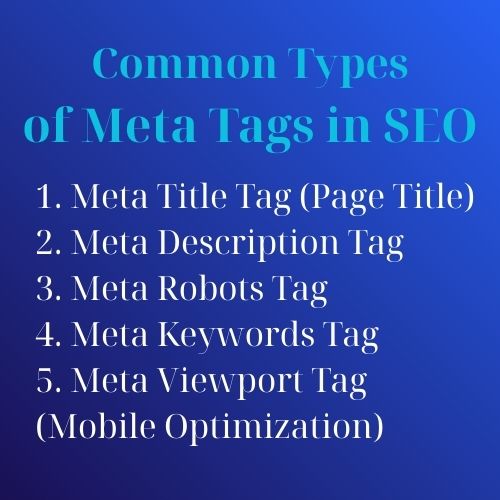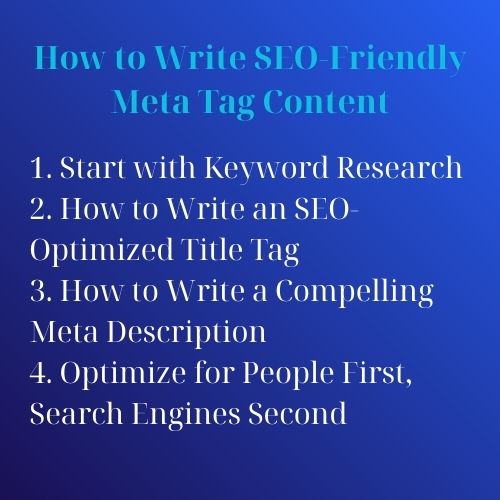What Are Meta Tags & How to Write SEO-Friendly Meta Tag Content
Meta tags may seem small, but they play a powerful role in optimizing your website for search engines. So what exactly are meta tags? How do they contribute to website optimization, and how can you write effective meta tag content that follows SEO best practices?
This article will help you understand the most common types of meta tags, the specific role each tag plays in SEO, and provide a step-by-step guide to writing meta content that boosts your site's visibility. Whether you're writing on your own or using a content writing service, knowing how to craft strong meta tags is essential to improving your search engine rankings and attracting the right audience.
What Are Meta Tags?
Meta tags are small snippets of HTML code that give search engines key information about your webpage. Even though visitors won’t see them when browsing your site, meta tags play a critical role in how search engines understand, index, and display your pages in search results.
At Viet SEO Agency, we consider meta tags one of the building blocks of on-page SEO. When written effectively, they help your site stand out in search listings, improve visibility, and increase click-through rates (CTR) — ultimately bringing more visitors to your website.
1. Definition of Meta Tags
A meta tag is a short piece of code placed inside the
section of your webpage’s HTML. While it doesn’t appear in the main body of the page, it quietly delivers essential details about your content to search engines and other platforms.
For example, here’s a simple meta description tag:
<meta name="description" content="This is the page description, which helps improve SEO.">
This short line tells search engines what your page is about. When someone searches for related content, Google may display this description directly beneath your page title in the results, giving users a quick preview before they click.
2. Why Are Meta Tags Important for SEO?
Meta tags might seem small, but they have a big impact on how your site performs in search engines. Here’s why they matter:
- Help search engines understand your content:
Search engines like Google and Bing use meta tags as signals to figure out what your page is about. Clear, descriptive meta tags make it easier for them to index your site correctly.
- Increase click-through rates (CTR):
The meta description often appears in search results as a summary below your page title. A well-written description can grab attention, spark curiosity, and persuade users to choose your link over others.
- Control how your pages appear in search results:
Certain meta tags, like the
robotstag, let you tell search engines whether to index a page or follow its links. This gives you more control over which pages should be visible in search and how they should be displayed.
Common Types of Meta Tags in SEO
Meta tags are like behind-the-scenes instructions that help search engines understand your website and decide how to display it in search results. Each type of meta tag serves a unique purpose—from defining your page title to controlling how pages appear in search results.
At VietSEO, we’ve created a clear, practical guide to the most important meta tags so you can optimize every page of your website with confidence.
1. Meta Title Tag (Page Title)
Definition:
The title tag defines the official title of your webpage. It appears both at the top of the browser tab and as the clickable headline in search engine results.
Example:
<title>How to Write SEO-Friendly Meta Tags | Boost Google Rankings</title>
Optimization Guidelines:
- Length: Keep it within 50–60 characters so it displays properly on all devices.
- Keyword Placement: Put your primary keyword near the beginning for better visibility.
- Clarity & Impact: Make it descriptive yet enticing so users feel compelled to click.
Pro Tip:
Avoid stuffing your title with keywords. A natural, compelling title works far better for both SEO and user experience.
2. Meta Description Tag
Definition:
The meta description provides a short summary of your page content. It usually appears right below the title in search results and can influence whether people click your link.
Example:
<meta name="description" content="Learn about meta tags and how to write SEO-friendly content to improve your website’s ranking on Google.">
Optimization Guidelines:
- Length: Aim for 150–160 characters so the full description shows up on all devices.
- Keywords: Naturally include your primary keyword without overloading the text.
- Engagement: Write compelling copy that sparks curiosity and encourages users to click.
Note:
If you don’t write a meta description, Google will automatically generate one from your page content—which may not be as engaging or relevant.
3. Meta Robots Tag
Definition:
The robots tag gives search engines instructions about whether to index your page and follow its links.
Example:
<meta name="robots" content="index, follow">
Common Values:
- index – Allow search engines to index the page.
- noindex – Prevent this page from appearing in search results.
- follow – Search engines should follow links on this page.
- nofollow – Links on this page shouldn’t be followed or counted for ranking.
This tag is especially useful for controlling duplicate content or private pages.
4. Meta Keywords Tag
Definition:
This tag was once important for SEO, but Google no longer uses it for rankings. Some smaller search engines may still reference it, so it’s optional today.
Example:
<meta name="keywords" content="meta tags, SEO, website optimization, page description, meta description">
Tip:
You can skip this tag altogether or use it internally for reference—it won’t hurt, but it won’t help rankings on Google.
5. Meta Viewport Tag (Mobile Optimization)
Purpose:
In today’s mobile-first world, your site must display properly on all screen sizes. The viewport tag tells browsers how to scale your page on different devices, ensuring a smooth user experience.
Example:
<meta name="viewport" content="width=device-width, initial-scale=1.0">
Why It Matters:
A mobile-friendly website isn’t just good for users; Google also uses mobile usability as a ranking factor.
How to Write SEO-Friendly Meta Tag Content
Writing SEO-friendly meta tags is one of the simplest yet most powerful ways to improve your website’s visibility on search engines. A well-crafted title and meta description not only help search engines understand your content but also entice users to click on your page rather than your competitors’.
At VietSEO, we’ve compiled practical tips and proven techniques to help you write meta tags that align with both user intent and search engine algorithms—without sounding robotic or stuffed with keywords.
1. Start with Keyword Research
Before writing anything, take time to understand what your audience is searching for. Identify high-relevance, high-volume, and low-competition keywords using tools like:
- Google Keyword Planner – Great for finding search volume data.
- Ahrefs or Semrush – Comprehensive tools for keyword difficulty and competitor insights.
- Ubersuggest – A budget-friendly alternative with solid keyword suggestions.
The right keyword ensures your meta tags match real search queries and target the right audience.
2. How to Write an SEO-Optimized Title Tag
Formula:
Primary Keyword + Unique Value Proposition + (Optional Brand Name)
Example:
<title>How to Write SEO-Friendly Meta Tags to Boost Google Rankings | SEOMaster</title>
Optimization Tips:
- Unique for every page: Never reuse the same title across multiple pages.
- Put keywords at the front: Helps both SEO and users scanning search results.
- Keep it under 60 characters: Longer titles might get cut off on mobile or desktop.
- Make it compelling: Think of your title as a headline that needs to grab attention.
What to Avoid:
- Keyword stuffing (e.g., “Meta Tags, Meta Tags, Meta Tags for SEO”).
- Generic titles with no unique value (“Home Page” or “Untitled”).
3. How to Write a Compelling Meta Description
Formula:
Primary Keyword + Benefit/Solution + Call to Action (CTA)
Example:
<meta name="description" content="Learn how to write SEO-friendly meta tags that drive traffic and boost your Google rankings. Start optimizing today!">
Best Practices:
- Think like an advertiser: Your meta description is your first “ad” in search results.
- Create curiosity: Make readers feel they’ll miss out if they don’t click.
- Stay under 160 characters: This ensures the entire description displays in search results.
- Use a call to action: Words like “Learn,” “Discover,” or “Start” drive engagement.
4. Optimize for People First, Search Engines Second
Search engines value user experience more than ever. Always write meta tags that sound natural, are free of grammatical errors, and provide real value.
Golden Rules:
- Write for humans first; SEO comes second.
- Avoid awkward keyword stuffing that makes text unreadable.
- Check spelling and grammar—professionalism matters.
- Review your meta tags in search previews to see how they’ll look to real users.
Common Mistakes When Writing Meta Tags – Insights from VietSEO
Meta tags might look simple, but writing them incorrectly can seriously weaken your SEO efforts. At VietSEO, we often see websites make the same avoidable mistakes, resulting in lower search rankings, fewer clicks, and missed opportunities for visibility. By understanding these pitfalls, you can fix them early and keep your meta tags fully optimized.
Here are the most common errors to watch out for:
1. Keyword Stuffing
Some website owners try to “game the system” by cramming too many keywords into their meta titles or descriptions. Not only does this look unnatural to readers, but Google’s algorithms now penalize over-optimized content, which can hurt your rankings instead of helping them.
Better Approach:
Focus on one primary keyword per page, use it naturally, and write in a way that appeals to human readers first.
2. Duplicate Meta Tags Across Pages
Using the same meta title and description on multiple pages confuses both search engines and users. Each page on your site should have a unique title and meta description that reflects its specific content.
Better Approach:
Create tailored tags for every page, incorporating relevant keywords while keeping them descriptive and engaging.
3. Leaving Meta Descriptions Blank
If you skip writing a meta description, Google will automatically generate one by pulling random text from your page. The problem? It might not be compelling, accurate, or optimized for clicks.
Better Approach:
Always write your own meta descriptions. Treat them like short ads: clear, informative, and enticing enough to make users want to learn more.
4. Writing Meta Tags That Are Too Long or Too Vague
Overly long meta titles or descriptions get cut off in search results, while vague descriptions fail to grab attention. Both lead to lower click-through rates.
Better Approach:
- Keep titles under 60 characters.
- Keep descriptions under 160 characters.
- Use specific, action-oriented language that tells users what to expect.
If you want, I can also create a quick “Meta Tag Mistakes Checklist” so you or your team can instantly spot and fix these errors before publishing.
Do you want me to prepare that checklist for you? It’ll make SEO optimization much faster and easier.
Tools to Help Write and Analyze Meta Tags – Recommendations from VietSEO
Writing and optimizing meta tags doesn’t have to be complicated. With the right tools, you can generate SEO-friendly titles and descriptions, check for keyword placement, preview how they’ll look in search results, and even analyze multiple pages at once.
At VietSEO, we recommend the following tools to make your meta tag optimization process faster, easier, and more accurate:
1. Yoast SEO (WordPress Plugin)
One of the most popular SEO plugins for WordPress, Yoast SEO lets you:
- Easily add meta titles and descriptions to every page or post.
- See a real-time Google snippet preview as you write.
- Get color-coded indicators for SEO quality and readability.
Perfect for beginners who want a simple, integrated solution.
2. Rank Math SEO (WordPress Plugin)
A powerful alternative to Yoast, Rank Math offers:
- Advanced schema support for rich snippets.
- Built-in keyword analysis for meta tags.
- Bulk editing options to save time on large sites.
Great for users looking for more advanced control and automation.
3. SEOptimer
This online SEO auditing tool quickly analyzes:
- Meta titles and descriptions for length and keyword usage.
- Technical SEO elements like page speed and mobile optimization.
- Overall SEO health scores with actionable recommendations.
4. Meta Tags Analyzer
A straightforward online tool for:
- Checking meta tag length, relevance, and keyword density.
- Previewing how your tags appear in Google search results.
- Identifying duplicate or missing tags.
Simple and free, ideal for quick checks.
5. Screaming Frog SEO Spider (for Bulk Page Checks)
A professional-grade desktop tool that can:
- Crawl your entire website to find missing, duplicate, or overlong meta tags.
- Generate detailed SEO reports for large-scale sites.
- Integrate with Google Analytics for deeper insights.
Best for SEO professionals managing bigger websites.
Why These Tools Matter
By using these tools, you can:
- Save time on manual SEO work.
- Spot issues before they hurt your rankings.
- Ensure every page has optimized, engaging meta tags tailored for both users and search engines.





